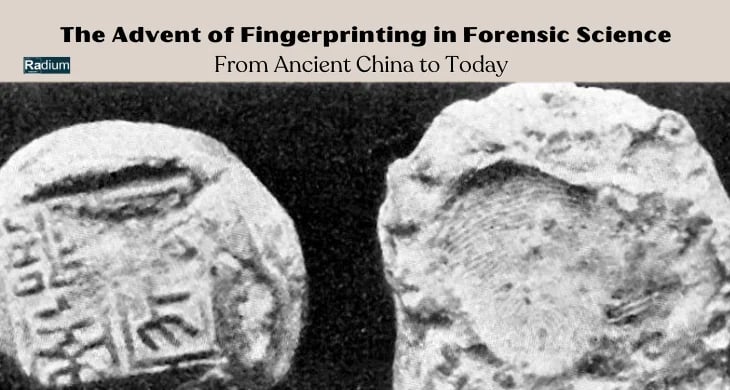The Advent of Fingerprinting in Forensic Science: From Ancient China to Today
Fingerprinting has been a key tool in forensic science, not only to reprogram the experience and conceptualisation of crime and identity as experienced by others.
Shubhanshi
3/1/20255 min read


Fingerprinting has been a key tool in forensic science, not only to reprogram the experience and conceptualisation of crime and identity as experienced by others. This entire process, grounded on the singularity and eternity of fingerprints via the singularity and identity of corresponding patterned arrangements in fingerprints, has progressed from simple methods a few centuries ago to today's digital approaches. Fingerprint has a long history, reflecting the quest of humankind to secure an automatic and reproducible identification scheme.
In this paper, the evolution of fingerprinting is traced from the beginning of the 19th and 20th century in the history of research, from ancient China and the Babylonia to modern scientific discoveries at the end of the 19th and 20th century. Moreover, it explains the hybridization developed for the previously reported forensic measures as well as security measures and focuses on the contribution of fingerprinting toward legislation and security policy globally and by law enforcement personnel.
Early Uses of Fingerprints
Ancient China and Babylon: Early Recognitions of Uniqueness
The earliest evidence of fingerprint identification for identification has been dated back from about two millennium ago in ancient China (200 BCE). Chinese regulation recognized the uniqueness of fingerprints and used fingerprints as personal marks on legal or commercial documents. Clay samples dLt and dLt printed on soft surfaces are represented similarly and can be controlled remotely, without the possibility of fraud.
An example of this is for merchants and scribes in Babylon, who employed fingerprints as a mode of signature in commerce. Fingerprints are on Babylonian clay tablets, which clearly indicates that even before the scientific ancestors of forensic science ancient people realised the usefulness of biologically idiosyncratic substrate.
Medieval and Renaissance Period: The Slow Progression of Fingerprint Study
Although a clear body of evidence exists about the fingerprint use in legal and commercial transactions, fingerprinting did not fall victim to the rigor of systematic research and application to forensic purposes in the Middle Ages. Some European scholars documented fingerprint patterns, but they remained an area of curiosity rather than scientific analysis.
Renaissance artists and scholars, such as Leonardo da Vinci, carefully analyzed the human hand, but the applications to forensic science were, at that time, unknown. Major advancements in fingerprint research only emerged in the 17th and 18th centuries.
The Birth of Modern Fingerprinting
19th Century: Scientific Advancements and Classification Systems
The 19th century marked a turning point in the study and application of fingerprinting. However, scientists and policymakers pushed the state of modern digital fingerprinting afterwards.
Jan Evangelista Purkyně (1823): The fingerprint patterns of 9 different patterns are named by the Czech physiologist as individuality and "inascriptibility" of patterns. His work set the foundation for later classification methods.
Sir William Herschel (1858): An Englishman in India, Herschel, employed fingerprints as a signature system to avoid deception, by enforcing, at the same time, an unmanageability of disavowal of having made a contract.
Henry Faulds (1880): A Scottish doctor, Faulds, has just made known a paper outlining the results of an experiment in which fingerprints seem to be employed for criminalising detection. He further commented on their durability across the subject's lifetime and on their possible forensic uses.
Francis Galton and the Foundation of Fingerprint Analysis
Sir Francis Galton, the English scientist and Darwin's first cousin, undertook a well defined study of finger print uniqueness. In 1892, he published Fingerprints, a foundational text that established fingerprint patterns—loops, whorls, and arches—as scientifically significant. The fact that no subjects, monozygotic twins included, have the same fingerprint as that reported by Galton's studies enables its application to forensic practice.
This article is a most useful contribution to the literature on developing the Henry system for classification. The papers of Dr. Galton, Sir Edward Henry (Inspector General), British Empire mainland, 1896, are described, namely, the publication of the Henry Classification System, 1896. This system categorized fingerprints based on specific patterns, making it easier for law enforcement agencies to catalog and retrieve fingerprint records efficiently.
After all, the fingerprint classification system was standardized by Scotland Yard in 1901 and later by all police forces all over the world and thus, the fingerprinting system resulted in that clearly, the only forensic identification method.
The Establishment of Fingerprinting in Law Enforcement
First Criminal Cases Using Fingerprints
The earliest crime to be solved using fingerprinting evidence is from 1892 in Argentina. Concretely, an Argentine policeman, Juan Vucetich, found a bloody fingerprint at the crime scene and convicted Francisca Rojas for having killed someone. Landmark case has also shown the confidence in fingerprints evidence to be applied in forensic sciences.
Scotland Yard in 1905 made successful use of finger print evidence for the conviction of a burglar, a first recorded use of finger print evidence in British law. Law enforcement fingerprinting has grown to an astonishing rate country (within country).
The Role of the FBI and Global Adoption
By the early 20th century, fingerprinting became an integral part of criminal investigations worldwide. The U.S. Federal Bureau of Investigation (FBI) established a fingerprint data bank as early as 1920s, which started to take and categorize millions of fingerprint records. Fingerprint identification enabled the law enforcement agencies to solve a vast number of criminal cases, apprehend offenders across jurisdictions and stop false convictions.
By the mid 20th century fingerprinting established itself as the standard identification technique for police, border control and for personal identification.
Fingerprinting in the Digital Age
Automated Fingerprint Identification Systems (AFIS)
The 1970s ushered in the Automated Fingerprint Identification Systems (AFIS) that changed forensic investigation. These electronic databases enabled police systems to match prints in a fraction of a second, which in turn resulted in greatly reduced time for identification of suspects.
AFIS not only solved the problem of ad-hoc classification, but also has the ability to promote the success of crime solving. At the end of the 20th century, the AFIS databases already existed, which, when combined, gave the ability to the global organizations, including Interpol, the means to share fingerprints within crime-fighting efforts.
The Rise of Biometric Fingerprinting
Fingerprinting technology has gone beyond a forensic technology in the 21st century. Biometric fingerprint readers are already being employed for mobile phone security, bank security, border control, and corporate security checks. These developments enhance the security and usability and robustness of fingerprint sensing.
In particular, fingerprint capture in latent form has been enhanced by exploiting modern forensic approaches, i.e.
Method development (e.g., Ninhydrin, cyanoacrylate fuming) for generating latent fingerprints on nonporous surfaces.
Technology based on laser scanning to detect invisible to the human eye prints.
DNA analysis of fingerprint residues, further improving suspect identification.
Challenges and Future of Fingerprinting
Despite its reliability, fingerprinting is not without challenges. Technical errors in data processing, misidentifications and privacy issues continue to be discussed. Until then, several innovations in the field of artificial intelligence and machine learning technologies have made it possible to raise the fingerprint detection accuracy and lower the number of human errors.
In the long-term, fingerprinting is foreseen to become increasingly embedded in the AI-based forensic system, which will help to increase the speed and precision of victim investigations. In addition, advances in the field of quantum cryptography and cybersecurity with the aim of safeguarding biometric information simultaneously to maintain law enforcement functions.
Conclusion
Although the method of fingerprinting has been used since its first introduction in ancient China and Babylon to current sophisticated applications, it has always been irreplaceable in forensic sciences. The development of this means of identification—from the most basic impressions of clay to the best biometric security systems—shows its everlasting importance in the fields of law enforcement, security, and even in day to day life.
As fingerprints are now increasingly assayable by technology, fingerprint analysis should continue to be at the core of forensic science to ensure justice and accuracy in criminal investigations. The development of fingerprinting is the most representative example of the human intelligence for the attainment of truth and security, and it has driven the means of identity confirmation and the legal system around the globe.
Solutions
Advanced identity verification and KYC services.
Quick Access
Access
© 2025. All rights reserved.
